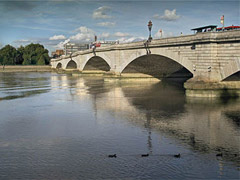


Primrose Hill, Marylebone and Notting Hill are among the most desirable (and expensive) parts of the capital, and across town it seems that annexing “village" to a district’s name, no matter how unnecessary, will give it instant kudos. Perhaps "Plaistow" and "Canning Town Village" will appear in time for the Olympics.
There are two types of village; the established ones, which are wealthy enclaves with wide pavements and trees, pretty bookshops, delicatessens and skinny-mocha-frappuccino outlets. Hampstead is the perfect example, which to quote one estate agent, “On a summer’s evening it is like being on the Med", presumably if your holidays on the Med include hayfever and drizzle. Primrose Hill, as well as having the prerequisite street with overpriced delis and a cupcake shop, was made hip by Kate, Sienna, Jude, et al. Marylebone Village actually looks like a village, with its quaint high street, a weekly Cabbages and Frocks Market and chic shops like Diptyque and lingerie shop Apartment 33. Wimbledon Village follows the same formula but is much further away from central London, hence its motto: “where town meets country".
Then there are the villages coined by overzealous estate agents. Do you know where Midtown is? Nor does anyone else, but for a fleeting moment estate agents thought that grouping Bloomsbury, St Giles and Holborn under this uninspiring moniker would raise the area’s profile (because these three areas are in dire need of publicity). And there really is no excuse for Swoho, which refers to south west Soho - what’s wrong with saying Soho without sounding like you have a dummy in your mouth?
Unlikely Villages
Among the more unlikely villages is Walthamstow. It’s the perfect solution for those who aspire to live in Highgate but lack the heaps of cash needed, or who don’t have the inclination to fess up to living in Walthamstow proper at dinner parties. It’s all very green, suburban and tranquil, with Victorian terraces and its very own conservation area. It’s also the cheapest bit of village dwelling you’re likely to find within the M25.
Highlights: There is an interesting tapas restaurant called Orford Saloon and a couple of quiet pubs.
\n\nSteeles Village is the most recent addition. Covering an area smaller than a diminutive estate, it encompasses the bottom stretch of Haverstock Hill. The idea of separating this patch arose when residents complained their area didn’t have enough of an identity, so they decided to divorce themselves from the rest of Belsize Park. Talks are still underway to have bus stops officially renamed, then all that needs to be figured out is which one of the two areas Gwyneth Paltrow’s house comes under.
Highlights: The Richard Steele pub with its bizarre cast of characters comes under the new demarcation, as does Oliver’s Fish & Chips. Alternatively The Hill Bar & Brasserie are jumping on the trend for American food with a menu offering mostly burgers and shellfish.
Blackheath in south London is not to be confused with Blackheath Village in Surrey, mostly because it isn’t really a village at all, however the organic food stores and expensive boutiques put it in the same league as Marylebone Village, minus the glamour (although there are a fair few mansions). There is no tube, therefore Londoners living north of the Thames won’t even know of its existence, but apparently it’s popular with families and visiting circuses.
Highlights: It’s very green, not as in eco-warrior, but as in everywhere you look there is a man flying a kite on a rugby pitch. With a wealth of gastropubs and cafes it’s little surprise the locals fiercely opposed a branch of Starbucks opening; as such the branch can only operate as a shop rather than a café.
\n\nWho knew that erecting a giant shopping mall would transform a rather grim part of East London into prime property. In the early noughties Stratford had very little going for it apart from a Pizza Express, and though it’s still far away from being an exciting cultural hub, the Olympics and Westfield have managed to raise house prices to unaffordable levels. Unfortunately the old shopping centre is still highly depressing.
Highlights: The largest indoor shopping centre in Europe. Views of the Olympic Village from certain heights/angles.
Surely no one with an iota of sense is referring to the area between Baker Street and Oxford Street as Portland Village, or to the stretch just north of Hyde Park as Connaught Village? Does anyone even live here with the exception of Claudia Winkleman? And it’s not like these are places that need to be put on the map either, as retailers on Upper Berkeley Street can testify.
Highlights: All the ones that existed previously in their original neighbourhoods.
Estate agents have been bandying ‘Noho’ around for several years now. Essentially the area north of Soho (for they are anything if not lyrical masters) while there is much to commend in terms of bars and restaurants, they all actually belong to a district called Fitzrovia.
Highlights: Without wanting to labour the point, Fino and the London Cocktail Club are in Fitzrovia, a neighbourhood with artistic ties – Virginia Woolf, Walter Sickert, Dylan Thomas and George Orwell all lived here. It’s hard to imagine Orwell waxing on about the streets of Noho.


